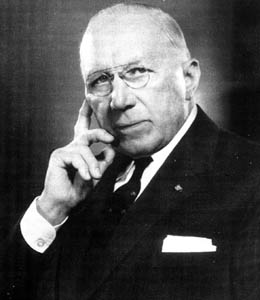Judge Edwin O. Lewis
In large part, Independence National Historical Park came into being because of the persuasiveness and persistence of Judge Lewis, first as President of the Independence Hall Association and later as chairman of the Philadelphia National Shrines Park Commission and the Independence National Historical Park Advisory Commission.
Meanwhile, the idea of a national park at Independence had attracted a champion far more influential than Ostroff. Judge Edwin 0. Lewis. A courtly Virginian, Lewis was an imposing presence, articulate, persuasive, and personable. Even those who disagreed with him usually found him likable. Charles E. Peterson, the National Park Service's leading expert on historic buildings, would, in the 1950s, often be at loggerheads with Lewis about the fate of nineteenth-century architecture within the park's boundaries. On a personal level, however, their relationship was cordial. Lewis, a consummate politician, maintained contact with a broad spectrum of people in the arts, business, and politics. He was also persistent and determined that any project for which he was responsible would be a success.
Like an earlier Philadelphia benefactor, Benjamin Franklin, Lewis was not a native of the city. Like Franklin, he came to Philadelphia as a young man to work as a printer. Like Franklin, he became active in various social and political circles, and was a tireless worker for the civic good of his adopted city. Edwin 0. Lewis was born in Richmond, Virginia, where, at the age of fifteen, he learned to operate a linotype machine. In 1896, when he was sixteen years old, he came, by steamboat, to Philadelphia. He worked nights as a linotype operator, first at the Philadelphia Press and then at the Public Ledger, both in the Independence Hall neighborhood, and later at the North American at Broad and Sansom Streets. The newspapers were his liberal education.
However, the newspapers did not provide Lewis with enough formal education to enter law school. So for a year he attended a tutoring school, which met in the old courthouse behind Congress Hall. He worked at night and went to classes during the day. He went through the University of Pennsylvania Law School in the same manner. It was a grueling schedule, but Lewis seemed to thrive on it. Obtaining his degree in 1902, Lewis began to practice law and quickly became involved in local politics, first as a Democrat, then as secretary of the independent City Party, and eventually as a Republican. In 1907 he was elected to the City Council, serving two years, and from 1912 to 1916 was first assistant city solicitor. After a brief period out of politics, he returned to office as a judge in 1923 and by the late 1930s was president judge of Common Pleas Court number 2 for Philadelphia County. When the Japanese bombed Pearl Harbor on December 7, 1941, Lewis was president of the Pennsylvania Chapter of the Sons of the American Revolution. Concerned with the potential danger to Independence Hall from enemy bombing, and the certainty of continuing deterioration, he appointed a committee of architects to consider the problem. He named D. Knickerbacker Boyd as chairman of the committee.
David Knickerbacker Boyd, FAIA, was an architect perhaps as well known for his services to the profession as for the buildings he designed. Credited with being one of the first to espouse the set-back principle for the design of tall buildings, he had served as consultant to various federal departments and state and municipal governments, as well as to the Russell Sage Foundation. A former president of the Philadelphia Chapter and Pennsylvania Association of the AIA, he had also been secretary and vice-president of the national body. In addition to his architectural activities as a professional and volunteer, he was interested in patriotic and historical affairs and was a long-time member of the Society of the Cincinnati and the Sons of the American Revolution.
His involvement with Independence Hall went back to 1915, when he had collaborated on a design for a park fronting the building across Chestnut Street. Boyd's personal qualities would be useful in his new assignment. According to his daughter he combined great tact, and the ability to defuse controversial situations with wit, with the intensity and drive to see a project through to completion. Boyd also had the time to devote to the project because his architectural practice had suffered during the Depression.




